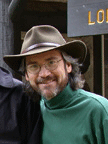Blogger Graphics
Oh! The Places You'll Go
By: Dr. Suess
Publisher: Random House Children's Books
Copyright: 1990
Genre: Fiction, Character Education, Picture Book
Grade Level: Any Age
Brief Synopsis:
Illus. in full color. "Don't be fooled by the title of this seriocomic ode to success; it's not 'Climb Every Mountain,' kid version. All journeys face perils, whether from indecision, from loneliness, or worst of all, from too much waiting. Seuss' familiar pajama-clad hero is up to the challenge, and his odyssey is captured vividly in busy two-page spreads evoking both the good times (grinning purple elephants, floating golden castles) and the bad (deep blue wells of confusion). Seuss' message is simple but never sappy: life may be a 'Great Balancing Act,' but through it all 'There's fun to be done.'"--(starred) Booklist.About the Author:
Dr. Seuss- It s difficult to imagine the children s book landscape without Dr. Seuss, who is, almost half a century after The Cat in the Hat, the best-recognized children s book writer in the country. But until Dr. Seuss -- a.k.a. Theodor Seuss Geisel -- reinvented the genre with his colorful and exuberant Sneetches, Grinches, Zaxes, and Zooks, children s books were often little more than literal-minded lessons and cautionary tales intended to transform young readers into productive citizens.
Themes: - Inspiration for life
- Helping to guide a person's path in life
- Encouragement to reaching your goals
Pre-Reading Activities:
- Have students write a list of their goals in their journal. They can be long term or short term. For the short term goals have them set a date and try to reach it by the end of the year.
Post Reading Activities:
- Have students try to write a story like Dr. Seuss. They can try to use inventive, silly words in their stories. After they are finished they will read it aloud to the class. Drawings should be included as well with their writing portion.
Reflection: This is another classic book that I could not leave out of my blog. It is an inspiration for many people and is a very popular baby and graduation gift. I actually quoted the last line of this book in my graduation speech in front of thousands. Dr. Seuss creates very fun and educational books for children, but they are also something that adults still enjoy. Definitely a book that needs to be kept in my classroom at all times.
Links:
































